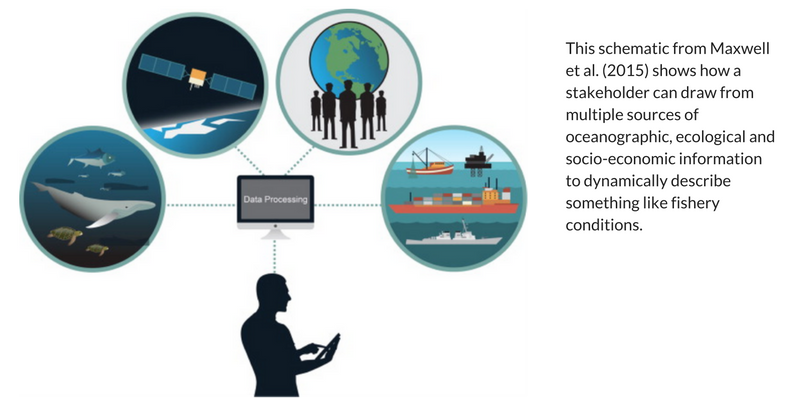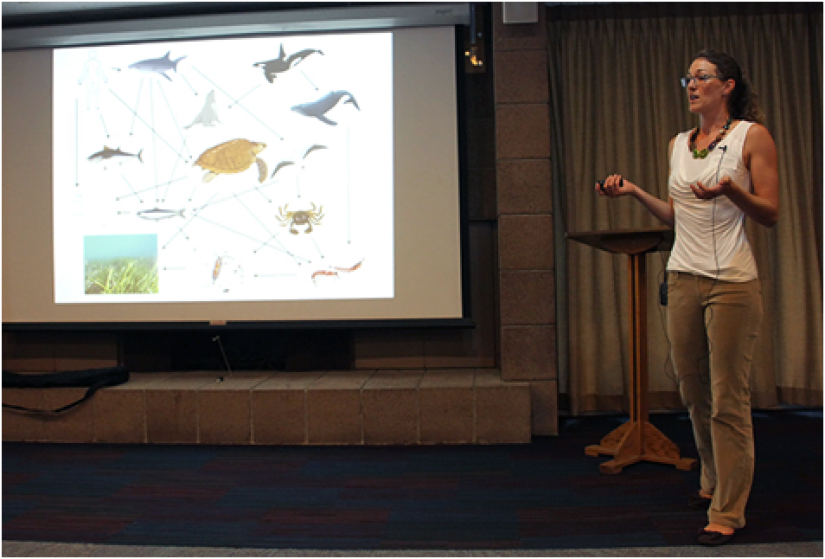This is not to say that the intersection between science, management, policy and the public is a vacant or boring place, in fact just the opposite. It’s extremely dynamic. Lucky for me, I get to navigate this dynamic environment while working on Dynamic Ocean Management. How apropos.
What is dynamic ocean management? It is an adaptive approach that uses near real-time data to inform the spatial and temporal distribution of management actions. For example, consider a common fisheries management approach: a static time-area closure. Something like no large mesh drift gill netting for swordfish in the Pacific Leatherback Conservation Area (PLCA) from August 15 to November 15.

A dynamic management approach would be to instead assess the environmental conditions of small sections of the large closure using a moving window.

In doing so, it’s possible to make fine-scale predictions regarding the likelihood of catching the target species, swordfish, and the likelihood of catching a non-target protected species (known as "bycatch"), critically endangered Pacific leatherback sea turtles. Being able to make these reliable predictions in parallel is transforming the way we are able to manage fisheries. So maybe one day instead of closing the entire PCLA to drift gill net fishing for three months each year, only small sections of the area with high likelihood of bycatch would need to be closed. And these closures could be re-assessed every few days to update the probabilities.

Dynamic management creates a win-win situation for U.S. fisheries and species conservation: fisheries could operate in more locations for more of the year while avoiding interactions with protected species.
Sounds great! Let’s do it! Well, not so fast…
Here we are, on the road less traveled. Where researchers, managers, policy-makers, conservationists, and other stakeholders alike are feeling uncomfortable. Uncomfortable at the prospect of changing the way fisheries are managed, uncomfortable at the prospect of more (albeit different) regulations, uncomfortable at the thought of relinquishing time-area closures it took years to establish, uncomfortable at the thought of widely sharing hard-to-collect data on endangered species with bleak recovery trajectories. They are all uncomfortable because they care so much. But just because we are uncomfortable doesn’t mean that we aren’t doing it. We are! It’s a democratic, time consuming, science-intensive, and windy process, but everyone is working together toward the same objectives, which are improvements to the current situation of fisheries that could operate more efficiently, and bycatch that could be avoided. Progress isn’t possible without change, and so to quote my beloved Sam Cooke, “A change is gonna come.”
It’s been so fun being part of such a dynamic process, a dynamic team (see team photo below!), and a dynamic solution to important marine issues. The meeting of minds is a great place to spend time learning about dynamic ocean management. I’ve been to a Pacific Fisheries Management Council Meeting, a few Highly Migratory Species Management Team meetings, participated in collaborative meetings of academics, researchers, managers and fishers, and have read a lot of technical reports trying to make sense of the last two decades of regulations to reduce the bycatch of protected species in the West Coast large mesh drift gill net fishery. In an effort to save the next few dozen people who need to do the same, I am working with a Stanford PhD student, Julia Mason, to compile all the nested layers of information into a one-stop-shopping open-access, online, interactive fishery profile. I’ve worked with Alicia Amerson, a Sea Grant Fellow in the office of Lieutenant Governor Gavin Newsom, to concisely convey what Dynamic Ocean Management is and why it’s important to all California state policy makers. I also think it’s imperative to relay the latest and greatest marine resource use management solutions to the next generation of dynamic individuals who will be soon be our colleagues, and so I’ve given talks to regional undergraduate marine policy classes. I can’t wait to see what dynamic solutions they’ll come up with!
Written by Lindsey Peavey
Follow @lepeavey on Twitter


Citation:
Maxwell SM, et al. (2015) Dynamic ocean management: Defining and conceptualizing real-time management of the ocean. Mar Policy 58:42–50. https://www.sciencedirect.com/science/article/pii/S0308597X15000639?via…